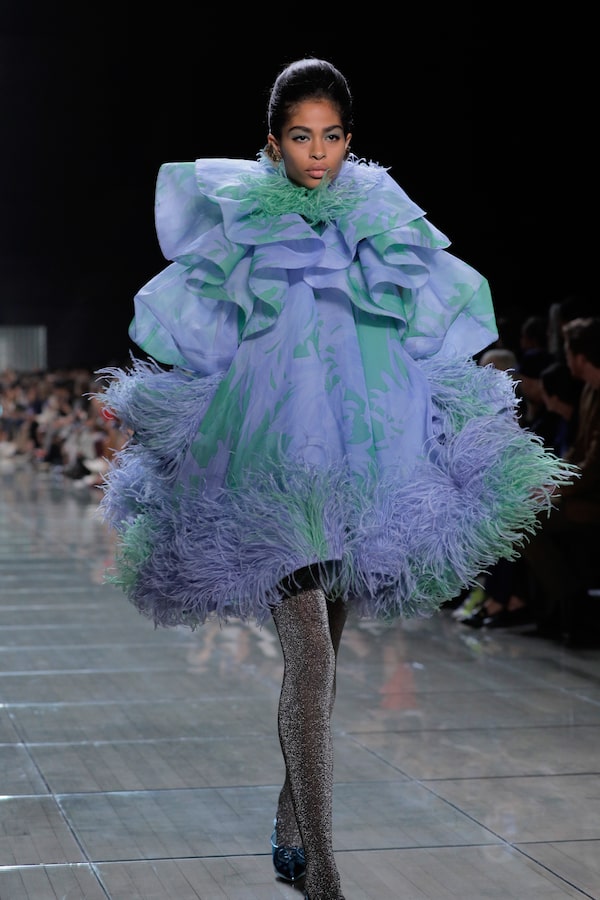Get ready for the must-have fads of the season! Think teal! High-low hemlines! Monochrome! Clashing patterns! Skinny pants! Pleated culottes! “Scumbro” à la Justin Bieber! Don’t forget folkloric. Lace. Florals. And if the luxe minimalism from COS and Victoria Beckham is not your thing there’s maximalism, too – explosions of tulle, encrusted appliqué sequins and jacquards from Marc Jacobs and Rodarte.

A model walks the runway at the Rodarte show on Sept. 9, 2018 in New York City.Slaven Vlasic/Getty Images
With two-thirds of the calendar year behind us, including the industry’s Fashion Month and the return to school, the concept of trends should be history, too. Traditionally, September marks what I always think of as the start of fashion’s annual trend cycle. It’s the time of year style pundits appear on programs to rhyme off a helpful list of the “next big X” in fashion. But as I read the wrap-ups and listicles generated by this annual parade, and as a former style editor, it all feels heretical to me. I no longer think it’s possible to forecast trends in a way that has value, except, possibly, as entertainment. The only grand theory of fads worthwhile these days is that there isn’t one. And it’s about time.
It feels like we are (finally) coming out the other side of what fast fashion has wrought. Fifteen years ago, I remember marvelling at Zara’s responsive supply chain, short lead times and accelerated delivery schedule for getting new goods onto the sales floor – just three weeks to their competitors’ three to five months. They created today’s accelerated consumer appetite. But there are signs the industry is overdue for a market correction. This year, financial results for Inditex, the parent company of Zara and the world’s largest apparel retailer, have reflected sluggish sales, even as the brand expands online to keep pace with rival Amazon. H&M, the second-largest clothing retailer, has only just started digging itself out from an inventory crisis of several billion dollars worth of unsold stock it discounted deeply to clear out (as revealed in its March, 2018, earnings results).
What’s become clear is that, as various fashion-industry covering publications try to sift trends off the runway into tidy categories for readers, giant retailers are also paying attention. But the trends they’re betting on are landing with a thud. And a consumer shift away from traditional fashion sources, such as magazines, means that a fad pinpointed to a moment doesn’t have an expiry date any more. Simply, there’s no one fashion magazine authoritative enough to declare that fad is In or Out (note: In/Out lists are definitely Out.)

A model walks the runway during the Marc Jacobs Spring 2019 show at Park Avenue Armory in New York City.Randy Brooke/Getty Images
Pity trend-forecasting services, such as World Global Style Network, which uses its divining rods 24 months in advance to try to guess what’s going to be popular. The insistence of magazines imposing overarching trends assumes a single audience, and technological disruption is just one contributor to the erosion of the old hierarchical structure.
Behind the scenes, retailers and suppliers deal with volatility, uncertainty and shifts in the global economy as well as decreasing foot traffic and a steep decline in bricks-and-mortar sales, according to a report last year from Business of Fashion and McKinsey, called The State of Fashion 2018. The digital shift hit department stores especially hard (Sears Canada closed its last store in January, and after the Christmas holidays, venerable Henri Bendel will shutter its Fifth Avenue flagship and all 22 other locations).
There can no longer be a prescription for style because in the attention economy, taste is capricious and influenced by so many more variables, from platforms to subcultures to practicality to major events (nobody predicted the penchant for pinks and purples in the wake of the Women’s March; the realization came with hindsight).
Fads vary as often as the dropdown suggestions in Google’s predictive search feature – except fashion predictions have become even more seemingly random, resembling something more like Mad Libs. Disparate customized digital channels and platforms, everything from streaming television to consuming fashion news on social media, are just some of what create complex tastes that are impervious to a single or even a handful of influences. It allows for multiplicity that I think of as a glorious cacophony. Anything goes, and there has never been a better time for choice because the offering today is a hodge-podge – for tastes that run from futuristic fringe to eighties throwback, chances are someone, somewhere is making something just for you.
With a style zeitgeist this fragmented, it’s hard to predict what’s next. The best way to make sense of the voluminous fashion information we have immediate access to today is to not bother.
Visit tgam.ca/newsletters to sign up for the Globe Style e-newsletter, your weekly digital guide to the players and trends influencing fashion, design and entertaining, plus shopping tips and inspiration for living well. And follow Globe Style on Instagram @globestyle.